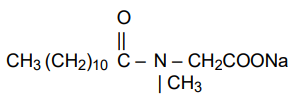Knowde Enhanced TDS
Identification & Functionality
- Chemical Name
- INCI Name
- Ingredient Origin
- Cleaning Ingredients Functions
- Cosmetic Ingredients Functions
- CAS No.
- 137-16-6
- EC No.
- 205-281-5
- Technologies
- Product Families
- Preservative
Sodium Benzoate
- Chemical Structure

Features & Benefits
- Benefit Claims
- Labeling Claims
- HII Features
- Functional Properties
- Mild
- Sulfate-Free
- Foam Booster/Stabilizer
- Wetting Agent
- Good Detergency
- Corrosion Inhibitor
- Increases solubility of other surfactants.
- Compatible with anionics, nonionics, and cationic surfactants.
- Stable in neutral to moderately acidic formulations.
- High Salt Tolerance
- Emollient
- Conditioner
- Good Rinsibility
- Low Cloud Point
- Rapid Biodegradability
- Biodegradability
Product is readily biodegradable.
Applications & Uses
- Applications
- Bath & Shower Applications
- Hair Care Applications
- Home Care Applications
- I&I Cleaning Applications
- Personal Hygiene Applications
- Skin Care Applications
- End Product Uses
- Shampoos
- Manicuring Products
- Bubble Baths
- Aerosols (shaving creams, shampoos, etc.)
- Alkaline Cleaners
- Automatic Dishwasher Rinse-Aids
- Liquid Dishwashing Detergents
- Rug & Upholstery Shampoos
- Aerosols (window, upholstery cleaners, etc.)
- EmulsionPolymerization
Properties
- Physical Form
- Appearance
- Clear liquid
- Typical Properties
| Value | Units | Test Method / Conditions | |
| Actives Content (MW 293) | 30 | % | — |
| pH (5% in aqueous solution) | 8 | — | — |
| Color | max. 2 | — | Gardener Scale |
| Residual Fatty Acid (as Sodium Laurate) | 2 | % | — |
| Boiling Point | min. 100 | °C | — |
| Cloud Point | -2 | °C | — |
| Freeze Point | -2 | °C | — |
| Flash Point | min. 94 | °C | PMCC Flash Point Tester |
| Viscosity (at 20°C) | 29 | cPs | — |
| Viscosity (at 60 °C) | 15 | cPs | — |
| Density (at 20°C) | 1.03 | g/ml | — |
| HLB | 29.8 | — | — |
| Regulated Volatile Organic Chemicals | 0 | % | U.S. EPA |
| Pour Point | 3 | °C | — |
Regulatory & Compliance
- Certifications & Compliance
Safety & Health
- Health Effects
MAPROSYL 30-B is practically nontoxic orally (LD₅₀ > 5000 mg/kg) in rats. The product is severely irritating to eyes and causes mild to moderate skin irritation at 30% active. See SDS for further information.
Packaging & Availability
- Packaging Type
Storage & Handling
- Storage & Handling
- Normal safety precautions (e.g., gloves and safety goggles) should be employed when handling MAPROSYL 30-B. Contact with eyes, nose or prolonged contact with skin should be avoided. Wash thoroughly after handling MAPROSYL 30-B.
- Non-Bulk Storage Recommendations: MAPROSYL 30-B should be stored in closed containers and kept in cool, dry place away from incompatible materials (see Section 10 of the SDS). It is recommended that MAPROSYL 30-B be stored in sealed containers and kept at temperatures between 50°F (10°C) and 120° (49°C). Avoid overheating or freezing. If material is frozen, mild heat and agitation are recommended to ensure the material is homogeneous before use. If material is frozen it should be heated gently and stirred to ensure is homogeneous prior to use.
- Workplace Exposure
Occupational exposure can occur primarily through skin contact or via inhalation of vapors and mists. Engineering controls, personal protective equipment, and other workplace safety practices should be used to control these exposures.